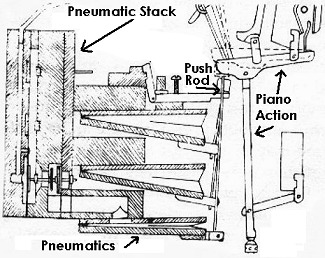RagPiano.com - Guide to Ragtime and Player Pianos and Mechanical Music
Player Piano History and Evolution
An Essay on the History and Principles of the Automated Piano
by Bill Edwards
Contents Copyright ©2002/2004/2015 by William G. Edwards
Even before these days of MIDI generated music, Player Pianos had a certain nostalgic air about them, one that evoked memories of happy times for adults, and created an air of wonder and mystery for children. If there is any type of music that player pianos are most associated with, it is Ragtime, since their popularity grew during the ragtime era and peaked shortly thereafter. Even though rolls are still being produced to this day, including many of contemporary radio hits and those from the Movies and Broadway, a large number of people that see a player piano may still associate them with tunes such as Black and White Rag or The Jelly Roll Blues. In truth, the idea for an instrument that could play without the benefit of a musician goes back much farther than the early 20th century.
The first successful attempts
A German hand-cranked barrel organ.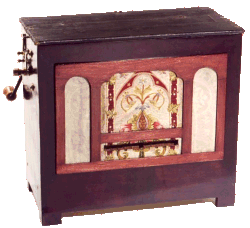 |
at creating such a device were made in the early eighteenth century. These contraptions used cylinders or disks with pins on them to open valves that sounded organ pipes, similar to the mechanical method utilized in a music box where the pins pluck on tuned tines. The early instruments of this type evolved into the hand cranked barrel organ, which is still the instrument of choice for street corner organ grinders. But the cylinders or disks were also used for large organs at that time, with the eventual goal of applying them to other keyboard instruments. Both devices were at a disadvantage because it was a fairly tedious process to create either a cylinder or a music disk, and mass production would have been difficult if not impractical. Not only that, but the continued cranking of the organ, a action which looked as if one grinding meat, thus the well-known colloquialism, required a good deal of stamina even for a short time. In addition, the size of both media was static, which limited the amount of music that could be reproduced without changing to another cylinder or disk.
The next advance was a method created by Claude-Felix Seytre of France in the 1840s. It was a technology that was somewhere in between the cylinder and the modern paper roll. His method utilized a roll of near-cardboard thickness paper that passed over a plate with pins, which in turn triggered the mechanics necessary to play a note. Again, these were first applied to organs, as the piano was still evolving and piano action mechanics were still somewhat primitive. The music roll was pulled by a sprocketed gear, and was usually hand-cranked. It was a quick evolution from this to the modern piano roll methodology first constructed in the 1850's. The next step was created by Alexander Bain of Great Britain, who utilized paper of regular thickness pulled between rubber coated pinch rollers.
Modern player piano mechanisms are not too much different in theory from the first pneumatic devices of the late nineteenth century. They were the first to use the familiar paper roll with perforations in it. These devices utilized a vacuum system that created suction so that when a hole on the roll passed over a vent on the tracker bar (the long brass or nickel-plated piece with holes in it), it interrupted the vacuum on a valve connected to that vent, rerouting that vacuum to a small pneumatic bellows. This collapsed the bellows, which had a rod connected to it, and the rod pushed either downwards onto a piano key, or on later devices, upwards directly onto a part of the piano action that pushed the hammer into the string. This same methodology was applied to percussive instruments, such as orchestra bells or drums, and to organ pipes as well, creating band organs.
An early Aeolian Pianola 65-note
push-up piano player.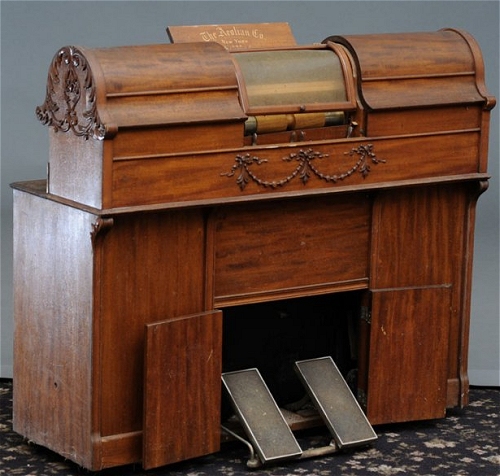 |
Early devices created vacuum through the efforts of an individual pumping the atmosphere out of a large pair of bellows. Later devices utilized an electric vacuum motor.
The earliest home piano playing devices, which were available in both Europe and the United States as early as the mid-1880s, were literally piano players. The German name was vorsetzer, or "front sitter". Americans commonly called them push-ups. They rolled up to the front of the piano, where the overhang containing the plungers could pushed down on the keys. These devices, as well as the first internal players of the early 1900s, used rolls that played only 65 notes instead of the full 82 to 85/88 of later pianos. (Many 19th century European and American pianos lacked either the top three or, less often, the bottom three notes of the modern piano). They were difficult to calibrate correctly, and if the felt came off any of the plungers a performance would be accentuated by noisy clicks.
Many inventors worked at creating a device that would fit inside of a piano. It should be noted that from the 1880s into the early 1900s, the upright piano was still undergoing its own evolution. Earlier upright actions had the dampers, which stopped the lower strings from vibrating when pressed against them, located above the hammers instead of below, where they are located in the modern upright. This so-called "birdcage" type of action made tuning and maintenance difficult, so grand pianos and the short-lived square grand were still the instruments of choice. Once the upright evolved into a maintainable and very affordable instrument, the otherwise vacant area in the lower half of this piano became a logical container for the vacuum components and the player mechanism. By making the cabinet a little deeper, the spool box and tubing could easily fit in the upper section above the keys. And so was born the modern player piano.
If there was one company that was most responsible for the popularizing of mechanical music in the early 1900s, it would probably be considered as the piano manufacturer
Aeolian. They did it largely by advertising more than just their product, achieved by focusing on the social benefits of automated pianos as well. No more were years of music lessons necessary to enjoy well-played music in the home.
Roll Perforator used by Mike Meddings for creating Jelly Roll Morton arrangements.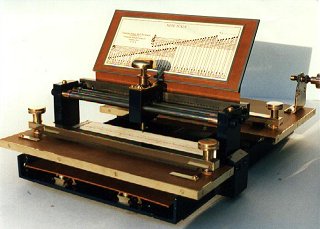 |
Even the children could have the satisfaction of participating in music making at family gatherings, thus building their self-confidence (and leg muscles). Additionally, both classical pieces and most all of the popular songs of the day were available on rolls for just a bit more cost than the corresponding sheet music. It was this psychology that helped launch an era in which player pianos were the most desired home instrument in the United States. Advertisements by Aeolian and many other manufacturers were in every magazine and newspaper of the time, and many merchants that before had sold only music became dealers in both rolls and the pianos that played them. It wasn't long before coin-operated pianos were available in restaurants and other public venues, and they soon appeared in the movie houses of several small towns across the country, usually in lieu of having to import talented artists to accompany "photo plays" on the silver screen.
However, there were some deficiencies that both musicians and many musically inclined inventors recognized. For starters, in the earliest days of rolls they were reproduced largely note for note from the sheet music. Early piano rolls were produced using a ruler and pencil as the primary markup tools, finished off with manual paper punches.
A Themodist piano roll with
an expression line.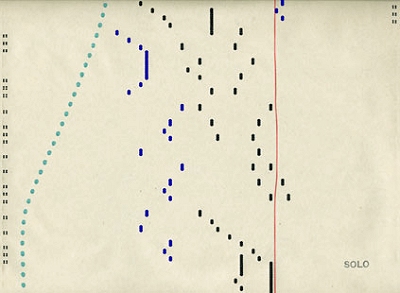 |
Fairly soon a perforator device similar to the one pictured on the left made the process easier as for the notes, as well as the timing of each beat. Arrangers were called in to help beef up the music, and almost overnight piano rolls started to sound as if the music was being played with four hands. Still, it was usually a bit too perfect and performances lacked a human touch, as a practical method had not yet been created for recording rolls from a live pianist. Also, expression, such as changes in tempo and dynamics, were entirely up to the person sitting at the piano and pumping the roll. By sliding the tempo lever or varying the pressure of the pumping, these changes could be instituted, but they still did not necessarily reflect the intent of the arranger, or once so-called hand-played rolls became available, the intent of the artist. Some companies produced rolls that had an expression line printed on them. By moving the expression (volume) lever to align a stylus with this expression line they could produce the desired dynamics as interpreted by the roll's editor. In most cases, where popular music of the day was what the consumer was listening to, the lack of expression did not matter all that much. But for those who clamored to have rolls of classical music for them to enjoy in their home, something had to be done to properly represent the intent of the composer and the artist.
Out of this need for better interpretation, the Reproducing Piano was born. This was an early method of performance re-creation which was astoundingly accurate considering the technology, and in many cases as convincing in reproduction as MIDI pianos are today.
The author with his 1926 Weber Duo-Art
reproducing grand.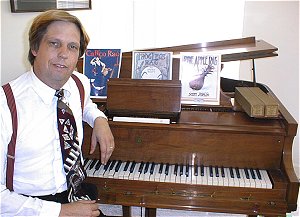 |
There were three major manufacturers of reproducing pianos, and many of their instruments are still in use today. They include the European originator of this device, Welte-Mignon, and two American companies, Duo-Art and Ampico. The principles of reproduction between the three vary only slightly. The first devices produced by Welte were the type that pushed up to the piano. It did not take long for them to find a place for the mechanism inside the instrument. As a matter of methodology, that had as much to do with the differences of piano actions between grands and uprights as it had to do with cost and the necessary complexities of equipment placement, nearly all of the reproducing piano actions were installed in grand pianos. There were a few, mostly Ampico, that found their way into higher-end vertical pianos. But the vast majority were put into custom built grand pianos that were more often than not very ornate and found in the homes of those who were well off, as well as many hotels and restaurants. The roll mechanism was either kept in a drawer below the keys, such as the Ampico, or behind a door below the music desk, such as in the Duo-Art. They universally used electric vacuum motors, with a few early exceptions.
In order to create media for this piano, a recording method had to be created in conjunction with the piano itself. Early experiments by
Ampico creator
Charles Stoddard were done using golf balls hit past electric sensors that used mercury as a damper.
An advertisement for Ampico touting their
impressive stable of serious pianists.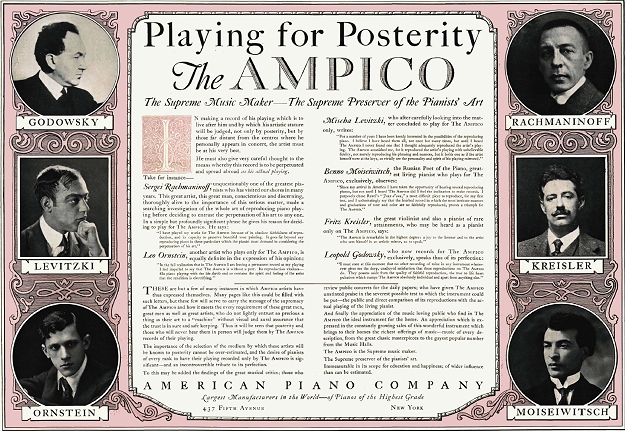 |
The velocity and acceleration of the ball was measured as it went past multiple sensors, producing a reading that could be applied to a set calibrated scale. In this way, the velocity of individual notes could, in theory, be recorded as a hammer moved past sensors on its way to the string. But in reality, reproducing pianos were usually divided between bass and treble, as tracking individual notes would have required an unwieldy roll and more bellows that the vacuum could handle. The velocity of a sing note (or group of notes) would then be applied only to the instance in which it was struck, and only to that half of the piano. In most cases, this was close enough to realize the artist's intentions of dynamics. The level of dynamics between loud and soft was incremented in anywhere from eight to sixteen levels. The pneumatics on these pianos were very rapid, so the level of vacuum allowed into the pneumatic fingers for a keystroke could easily be changed between the reproduction of a loud keystroke and a soft one just an instant later. In conjunction with tracks for the sustain and unacorda (soft) pedals, the artist's performance could be perfectly recorded, and reproduced with highly acceptable accuracy. Not only that, this medium allowed, for the first time, editing of a live performance to remove imperfections. Even at that, the editing often removed some of the spontaneity of a performance, even as it removed any of the errant unintended notes, and some of the dynamics were changed in editing for practical or personal reasons. Among artists that recorded for Welte, Ampico, and Duo-Art were
Sergei Rachmaninoff, Claude Debussy, Ignace Paderewski, George Gershwin, Artur Rubinstein, Zez Confrey, and many other prominent pianists from multiple genres of the early 20th century.
Meanwhile in the commercial world, some of the principles of recording reproducing rolls were applied to cutting conventional 82 note rolls, and suddenly the end product was not subject to the whim of the former music teacher who decided to take a job cutting perforations in paper that corresponded with notes on a score. An artist could play a performance that would put pencil marks down on a moving sheet of paper, and those marks could be edited and translated directly into a roll of a live performance that had more in the way of human timing and less of robotic accuracy. It was this technology that allowed us to hear, however briefly, how Ragtime composer Scott Joplin played in his last years. It also gives us a brief historical look at the ethics of the editing process.
Among the pieces that Joplin recorded in 1915 was his famous
Maple Leaf Rag. There are at least two distinct performances that exist today that were likely recorded within weeks of each other in early 1916.
The Uni-Record
Maple Leaf Rag roll.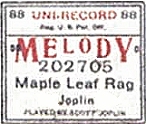 |
The Connorized
Maple Leaf Rag roll.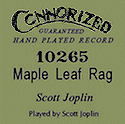 |
One of the rolls, released under the
Connorized label, gives us a somewhat embellished performance of the piece that is well played in most every way. Those who knew Joplin at that time later concurred that this must be a heavily edited representation of what the composer played, because they don't remember him improvising quite as much as the roll portrays, and further pointed out that his playing skills had deteriorated in conjunction with his diminishing health. Another roll, released under the
Aeolian Uni-Record label, probably portrays a more accurate performance. The timing is somewhat stilted, and the improvised embellishments are less apparent. Being that Joplin was suffering from the advance of tertiary syphilis at this time, and that he was never known as a great pianist, it is likely that his playing would have been very much like what is represented on the Uni-Record roll. Also, the Uni-Record rolls did not have the same step rate or granularity per inch that Connorized rolls did, which may have further denigrated the accuracy and timing of Joplin's performance. This brings up the ethical question as to why Connorized resorted to such heavy editing, likely perpetrated by staff artist
William Axtmann, at the expense of historical accuracy. It is likely in part because they wanted to sell a product with Joplin's name on it, specifically with him as the artist, but did not want to be responsible for the dissemination of a performance that would be unflattering to both them and the famed composer. This instance brings up questions of how much other "hand-played" rolls may have been altered before release, supposedly reflecting an accurate representation of an artist's performance.
It was the desire of both the pianists and the roll companies to continue to produce rolls of popular music with a "fatter" sound that helped evolved stride and novelty piano.
Zez Confrey |
George Gershwin |
Two prominent artists of the late 1910s and early 1920s led the way with innovative arrangements and performances that reportedly required little editing if any. They were
Edward "Zez" Confrey and
George Gershwin. Both performed under a variety of pseudonyms, so an accurate accounting of their entire body of work is difficult to ascertain. Still, the necessity of learning music and churning out arranged rolls at the rate of one to five in a session honed their compositional skills immensely. Two stride piano artists that started out by cutting rolls and became recording artists were
James P. Johnson and
Thomas "Fats" Waller. But the addition of pianistic runs, big chords, and fuller bass lines by these artists produced roll arrangements that could not easily be emulated by the average pianist, and helped to move ragtime and associated forms of music into a listening medium rather than one that the musical consumer could actively participate in.
By the mid-1920s, there was a shift from active musical participation to simply listening to tunes on records and radio that helped to sink the player piano's fortunes.
J. Lawrence Cook in the late 1920s.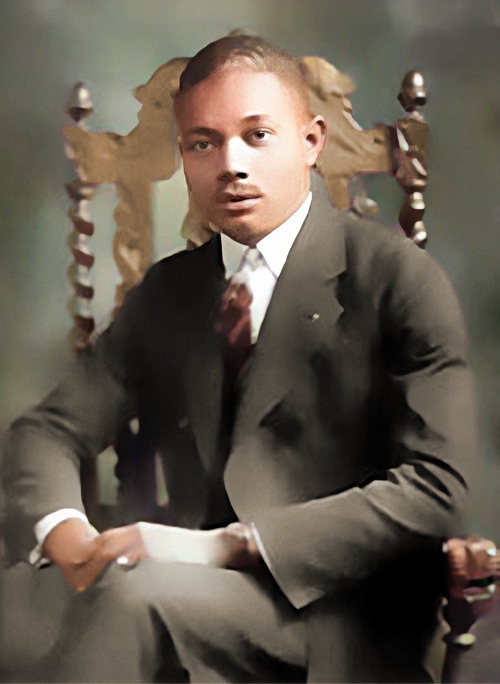 |
Although sales peaked in that decade, specifically in 1926, the advent of electronic recording and broadcasting allowed listeners to hear entire orchestras reproduced in their homes, and the player eventually sat idle in the corner, quickly becoming a novelty item left over from a bygone era. The worldwide Great Depression, which set in during the early 1930s, pretty much ended the production of player pianos and reproducing instruments. However, there was still a demand for the media, so rolls were produced consistently throughout the decade. Families that could not afford to go to the movies or to buy a radio could still obtain a piano roll of the latest hit song. Most of the piano rolls of this era came from a company owned by pianist/arranger
Max Kortlander, QRS, which had been in operation since 1900. The company's primary arranger, who used a special roll cutter in conjunction with a piano, was
J. Lawrence Cook. He had the uncanny ability of producing, one chord at a time, the performance of nearly any popular pianist of the day. It was largely through the efforts of these two men that contemporary music on piano rolls was available throughout the 1930s and 1940s, and they provided us with an additional valuable musical legacy from this period.
A 1950s Hardman Duo console player piano.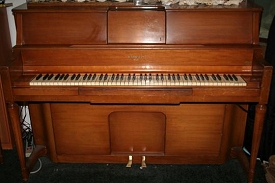 |
Following the Second World War, prosperity started to return to the United States, and there was a clear shift in living and social patterns. The suburbs were growing rapidly, and the advent of the Long-Playing record and broadcast television further propagated a desire for entertainment in the home. In addition, many parents wished to have their children learn the piano, now that the less intimidating console and spinet-sized instruments were available for the home.
Aeolian,
Kimball, and a couple of other manufacturers saw an opportunity here. So in 1949 they reintroduced the player piano to society. This time, the roll motor was electric, and the pneumatic sections of the piano were powered by an electric vacuum motor. This along with the use of some plastic components allowed for less weight and a more compact size, so the mechanism could be placed inside a piano just 36 inches high. A song was commissioned that same year to help boost sales, and the most popular piano roll song of all time quickly became a hit,
The Old Piano Roll Blues. Although sales were nowhere near what they had been in the early 1920s, there was enough of a market that traditional player pianos were available continuously through the remainder of the 20th century.
The next significant evolutionary step came in the 1970s. The
Marantz company in California created a device called the
Pianocorder™. It utilized primitive computerized circuitry to interpret data recorded on a cassette into signals that pushed electronic solenoids under the piano keys, and thus produce a "live" performance. It also allowed some latitude for user control of tempo and dynamics. The
Pianocorder was launched with a large library of early standard rolls reinterpreted to the new medium with dynamics and tempo alterations added. Most of the available reproducing roll library was also available on the
Pianocorder cassettes, as well as new recordings by contemporary artists such as
Liberace and
George Shearing made on a modern recording piano.
A Pianocorder-equipped Yamaha
from the 1970s.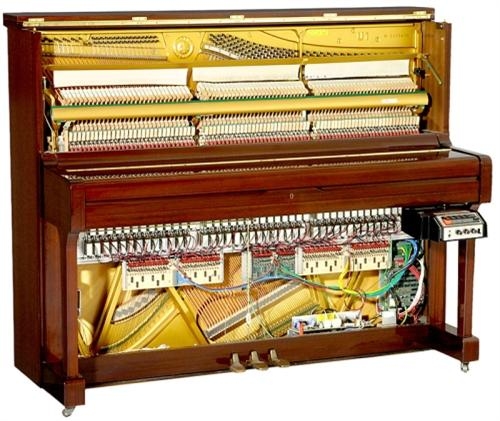 |
But what made this more revolutionary and exciting is that a reduced set of the recording capabilities were available to the consumer. Velocity sensors under the keys, coupled with a microphone near the sound board, allowed for relatively accurate recording of a pianist's performance onto a cassette for later digital reproduction on any
Pianocorder. Individual note velocities could now be registered instead of just a section of the keyboard. The entire mechanism could easily be installed in most any piano to boot. However, inherent difficulties in calibrating the devices and keeping them that way, as well as frequent solenoid burnout, hampered sales of the
Pianocorder and the idea all but died by the mid-1980s along with such frivolities as Quadraphonic sound (who needs sound coming from in back of you anyhow?).
As computer technology became more available and consumers showed a desire to have a computer and one of the newer electronic keyboards in their home, the
Roland corporation saw an opening and fervently worked on a method of combining the two. By utilizing and evolving many of the ideas of the
Pianocorder and consumer ready electronic synthesizers, they helped to create the
Musical Instrument Digital Interface, or
MIDI. Almost instantly, many recording artists desired to make recordings using this method because of the possibility of accurately editing their performances. They wanted to take advantage of other artistic opportunities as well, such as four-handed performances by the same pianist. Since that time,
Yamaha has led the acoustic piano implementation of MIDI with their
Disklavier, and many artists from jazz to pop have offered their talents for recording to this media. And again, a whole slew of performances from piano rolls dating back a century are available on this new technology as well.

 An exciting look at available technology
An exciting look at available technology that merges with the past is that of the oldest piano roll company still in business,
QRS Music. They not only have a roll library of nearly a century of recorded piano rolls, but there are also a number of
PianoMation™ devices available that turn your piano or player piano into a MIDI workstation. You can record piano rolls, play back MIDI sequences, or combine technologies to bring your old player piano into the 21st century. They also have an extensive MIDI library of piano roll and live recordings as well. For the true player piano enthusiast, this is a worthwhile stop. Yamaha introduced their
Disklavier™ pianos with similar technology in the late 1980s. Another competing system known as
Pianodisc™ also provides an alternative to the legacy player piano with a digital system that like Disklavier can combine live piano with audio tracks, and can further read MIDI data directly from outboard devices or a computer, even playing files from the internet through a smartphone or tablet. The author has a Pianodisc system installed on his Petrof concert grand, and has enjoyed many of the possibilities it provides.
There are many possible ways to interface with Pianodisc music automation. |
Now that we are well into the 21st century, it seems that anything will be possible in the reproduction of music. While there have been many naysayers dating back to the origin of the player piano who have predicted the sorrowful end of live performance due to economic benefits of a non-human performer, even MIDI has not deterred the use of live piano performers in many bars and hotels across this country. One may predict that a MIDI piano will soon be able to take requests shouted from across the room using voice recognition software, and some smartphones already have that ability with YouTube or other media outlets. However, even given the merits of Apple's Siri, that piano won't have the personality or direct interactive nature of someone who has spent years honing the craft. Who wants to go watch a diminished orchestra perform with a vacant piano and various other MIDI driven sounds? In the case of an historical performance playing with a dead artist, such as George Gershwin via his many rolls, this may work to a point. However, there will always be some desire to listen to
and watch someone who has spent years perfecting the art of creating music acoustically without mechanical or electronic enhancements. The current evolution of MIDI and similar digital means provides us with a tool that can be used in composition, scoring, and dissemination of an artist's or composer's ideas over the internet. Indeed, many television shows and some movies are scored nearly entirely through MIDI samples and sophisticated Macintosh sequencing programs. But consider that it took a human (with rare exceptions) to produce the performance to begin with. So until we hear ourselves saying, "Hal... Hal... open the Pod Bay Score please.", musicians are still in control, and the player piano provides but one mode of "live" entertainment among a universe of possibilities.
Player Piano Principles of Operation
To understand how most mechanical music is reproduced, we should first understand the basic principles of the pneumatics used in the instruments. This section provides a simple clarification of the process that turns air into music. The bibliography, near the bottom of this page, will point you to further sources for information on mechanical music and rebuilding older instruments.
Many novices are under the impression that it is blown air that creates the motion that pushes down the keys in a player piano to play the notes that Jack built! In actuality, it is a vacuum system that pushes a rod up into a part of the piano action to send each hammer to the string, plus more pneumatics to drive the motor, activate the sustain pedal, and in some cases, control the dynamic level of the music. In the bottom of most upright players you will see at least two pump bellows and often times a third one to one side. Underneath the back end of most grand players you will see one large bellows next to an vacuum pump connected to an electric motor by a long belt. When either the foot pump or electric vacuum motor are activated, the main bellows, which are covered in a special rubberized airtight canvas, have the atmosphere pumped out of them. Since nature abhors a vacuum, the air is drawn back into the main bellows from other parts of the player action, most notably the spool motor and the tracker bar.
The spool motor in the vast majority of mechanical roll devices built through the 1920s was vacuum driven. The tempo is determined by the level of vacuum to the motor, and is controlled by a governing pneumatic bellow that regulates the amount of outside air mixed with the vacuum flow. The governor pneumatic has a spring inside that helps to assure a consistent speed for varying levels of vacuum. Most spool motors consist of three to five small bellows, referred to from this point as pneumatics. The motor pneumatics are staggered, much as the cylinders on a car engine, and attached to crankshaft that is in turn attached to sliding wood valves, helping to regulate the flow of air into the pneumatic that is currently collapsing.
An upright player spool motor and brake assembly.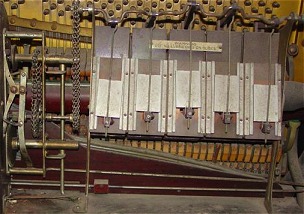 |
The pneumatic that is open the widest has the valve associated with it entirely closed, thus creating the greatest vacuum. As it collapses, the next widest one starts to collapse. By the time a pneumatic is collapsed, its associated valve is fully open, allowing air to flow back in as it expands again. This is all attached to a gear that drives a chain, and turns the lower spool in the spoolbox to pull the roll for playback. A gear changer diverts power to the upper spool for rewinding, but does not affect the direction of the spool motor itself.
The piano roll is placed on the upper spool and attached to the lower spool, which is how it is pulled over the tracker bar. The tracker bar is usually made of brass, sometimes nickel plated, and the front of it has a line of holes that are attached to small tube fittings on the back. Most tracker bars have a device that helps to align the perforations on the roll properly over the holes on the tracker bar. Some tracker bars have a transposition feature, which moves the center part of the bar to the left or right up to three positions either way, thus rerouting the intended location of the notes on the roll so the piece may be played in different keys. tracker bars can collect dust inside, potentially blocking the inward airflow. Special pumps are available for cleaning the dust out of a tracker bar. The bars come in varying configurations, depending on the type of player they are associated with. Some play only 65 notes while most play between 80 and 85 notes. Most tracker bars also include holes for sustain pedal activation and automatic rewind functions.
An Ampico reproducing piano
tracker bar diagram.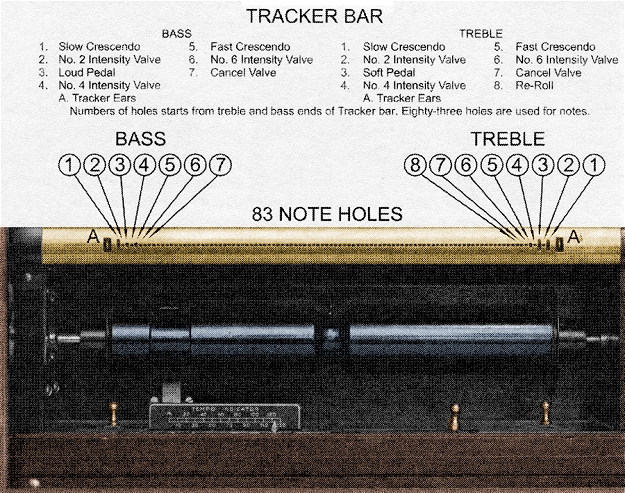 |
tracker bars on expression and reproducing pianos have additional holes to give directions for expression and accents. The assignments for an Ampico reproducing piano bar are shown in the diagram to the right. (Hover with the mouse to expand the image.)
Piano rolls are binary in nature. They can signal a note or function on or off, so they are a form of binary code similar to that used for electronic computers. The vacuum bellows create a constant vacuum suction through the holes of the tracker bar. When all of the holes of the tracker bar are exposed, the level of vacuum is so diminished that few if any notes will play, so there are some limitations to the number of simultaneous notes and the velocity at which they can be played. Each of the note holes is connected to an individual pneumatic assembly that is usually attached to what is commonly known as the stack. The stack is a large chest, often in two to four sections, that provides even distribution for the vacuum for the pneumatic assembly that plays each note.
In normal operation where a vacuum is present at the tracker bar, there is a valve between the vacuum chest in the stack and the pneumatic underneath the note. This valve is held closed by the vacuum in the chest, thus preventing a vacuum inside the pneumatic underneath the note. The note pneumatic remains in a relaxed state, and the note is not depressed. When the vacuum from the tracker bar is interrupted by a hole in the roll, the valve is opened by the change in pressure, and vacuum is then rerouted to the note pneumatic. This collapses the note pneumatic which has a push rod or lever attached to it. The push rod or lever pushes up on either the bottom of a key, or more often, the bottom of a part of the piano action that pushes up on the hammer. When the vacuum is again reinstated at the tracker bar, the valve closes and the note pneumatic again relaxes. Because of the small size of the note pneumatics, this change can take place as or more rapidly than a human can play, and with faster repetition than most pianists are capable of.
The pneumatics for the pedal work similarly to those for each note, except that heavier pedal pneumatics usually require a lightweight spring to assist their motion. When the vacuum is applied to the pedal pneumatic, it pushes directly up on the damper rod, pulling the dampers back from the strings and creating the sustain. Release of the vacuum on the pneumatic restores the damper position on the strings. Many pianos further allow the roll-pumper to control not only the sustain but the dynamic level as well, as discussed in the next section. Most have levers underneath a panel in the front of the piano that manually control the sustain and soft pedal functions, and some even have splits between bass and treble allowing the person playing the roll to soften either half of the piano selectively.
The fundamental operation of the expression piano is the same as that described above for the player. In fact, expression pianos were little altered from player pianos and were entirely compatible. However, there are extra holes on the tracker bar that help to implement some expression in a performance, mostly in the form of accents. There were a few companies that produced expression pianos, and a limited number of roll manufacturers that produced media for them. The most popular of these was the Themodist system developed by Aeolian as a graduated step between the standard player and their Duo-Art reproducing pianos. The note or chord accents were produced by two holes at the right of the tracker bar. When either or both holes were uncovered, an extra amount of vacuum was applied to the stack, which caused the corresponding notes to strike with a higher velocity due to a quicker pneumatic collapse. If certain notes were offset just slightly, such as melody notes aligned just a hair off from the chord notes, a melody could be easily accented over the accompaniment. This worked for bass lines as well.
To further create the illusion of the reproduction of the artist, and to involve the user as well, a long pointer with a stylus was attached to an atmospheric input valve on the stack, the end of the pointer being positioned at some point below the tracker bar, and all controlled by an expression lever in front of the keyboard.
An Aeolian Themodist system spoolbox.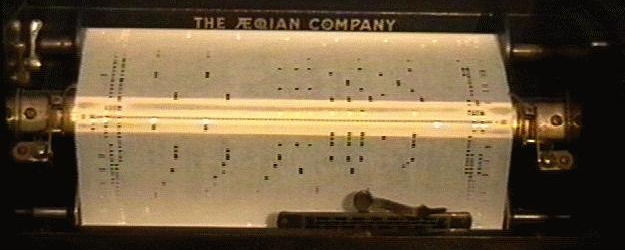 |
When the person pumping or "playing" the roll moved the expression control in conjunction with a stripe printed on the roll, one that was often accompanied by corresponding dynamic markings such as
mf and
pp, the level of atmosphere (in essence, the size of the leak) into the stack was altered, changing the velocity of the note pneumatics. The more atmosphere allowed into the stack, the softer the notes. The more vacuum that was reinstated, the louder the performance. Some non-hand played rolls also included tempo markings or a tempo stripe to give the "player" further cues over interpretation.
While this was a popular system, it had some drawbacks. First, it depended on the attention and skill of the person playing the roll to create the desired performance. Some users hoped that the system would be automatic. Aside from the accents, all of the expression was manual. Secondly, as atmospherics were increased or decreased, the level of vacuum to the motor was also affected, causing inadvertent tempo changes in the performance. Even so, a skilled roll player could apply good dynamics to any standard piano roll in a more even-handed manner than on the standard players that provided minimal control over bass and treble velocities. It was step above the standard, player but still a far cry from the reproducing systems described in the next section.
The fundamental operation of the reproducing piano is for the most part the same as that described above for the player and expression pianos. This section discusses the theory behind the methods for changes in dynamics and tempo, and the application of varying levels of accents. As mentioned before, the bibliography, near the bottom of this page, will point you to further sources for detailed information on understanding and even rebuilding and maintaining reproducing pianos.
Like the expression piano, the reproducing piano works on the principle of accenting single notes or groups of notes. It goes a step further however, and takes control over the total dynamic range of the piano. Holes on either side of the 82 or 83 notes on a reproducing roll used alone or in combination send codes to alter valve openings and collapse control pneumatics, which in turn automatically alter the ratio of atmosphere to vacuum in the pneumatic stack.
An elaborately appointed Knabe grand piano with an Ampico reproducing spoolbox drawer.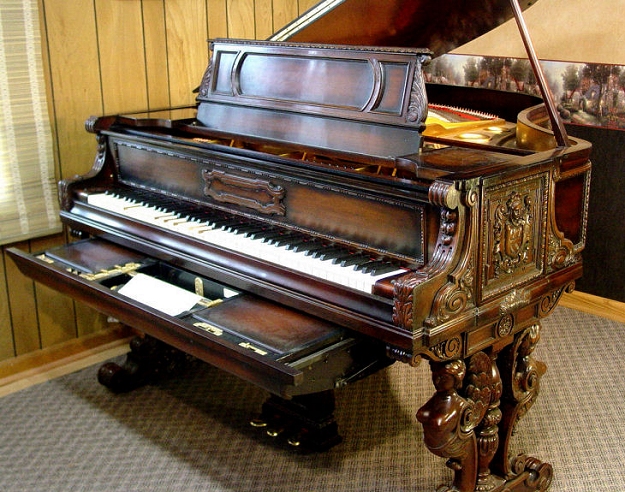 |
In most cases, multiple stepped pneumatics were used to provide between 8 and 16 levels of dynamics through the coding. By contrast, MIDI instruments have a range of 128 possible dynamic levels, but it is difficult for the human ear to discern a great deal more than 10 or 12 in context with the playing of a piano. The earliest
Ampico A models split this level control into lower and upper halves of the piano, but when the
Ampico B was produced in the 1920s, the need for such a split was negated by more effective coding. The thinking also was that it was rare for any pianist to utilize wildly varying dynamics between the hands, particularly on simultaneously struck chords. The
Duo-Art and
Welte Mignon worked on similar principles for their playback, but retained the left/right separation.
The larger difference between the systems was in the production of the rolls themselves. All three of the prominent systems had a limited number of recording pianos that used varying methods for capturing the keystrokes and dynamics of the artist. Anomalies during recording were likely frequent, as the systems ran on electrical current, and power supplies were inconsistent with variations in the level of amperage during the early days of generated electricity. Also, the recorded velocity of the keystrokes depended largely on the pianists' touch, and how well the recording components of the instrument were calibrated. But in general, such anomalies were usually "corrected" in the editing process.
At the end of a recording session, the roll came out of the markup machine with only pencil markings or ink blurs to indicate what had been played. The first order of business was to check for playing errors, such as bad notes or uneven phrases. This was done with a copy of the music in hand, if applicable, and often with the artist in attendance. In some cases, an acoustic cylinder or disc recording was also made at the session in an effort to determine intent, and for a better grasp on dynamics. Once the notes were in place, the coding was put in for the dynamics. Codes could consist of just one hole or a combination of holes to send varying signals for the collapsing or relaxing of the volume pneumatics attached to the stack. In many cases, it was at the discretion of the editor recreating the performance as to just how subtle these changes would be.
A Welte-equipped Steinway Grand with an upper spoolbox.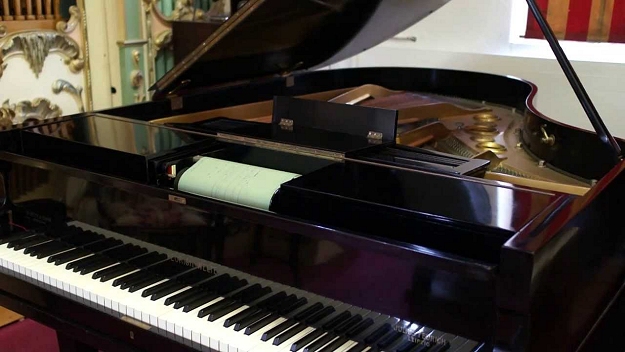 |
Often times it was not "exactly as the artist played it" as some advertisements may have boldly claimed, but how the editor heard it! Fortunately, there were times where the artist and editor were one and the same.
Where there was a need to bring out a melodic line or a quick accented chord at a different volume than notes that appeared to be struck simultaneously, the editor used a displacement method for the desired note. Since a well maintained reproducing piano with a tight vacuum was able to make dynamic changes exceedingly fast, these changes could be done rapidly leaving the perception that the note was truly accented. The accented note would be placed on the roll either just before or immediately after the notes that were to be unaffected, and the coding for an increase in volume would be in line with just those intended notes, followed by a coding to return the stack to the previous dynamic level. The opposite could be achieved for subito effects where sudden quiet is desired within louder passages. While it seems like a time-consuming process, the skilled editor could turn out many rolls a day, depending on the length of the piece and the level of micro-editing needed.
Reproducing pianos also allowed an extra level of control for the person playing the roll. There were different volumes for playback, varying from Solo (loud) to Dance (moderate) and Soft setting as well. Standard and expression rolls could also be altered, providing left and right control over the dynamics in mildly stepped levels. Some of the Welte pianos even provided a remote control system that allowed for a spool box to be kept in a closet or alternate room, so that the rolls and the player portion could be kept out of sight while the overall appearance of the piano was not altered by the necessary hardware. Similar systems were used in public settings as a novelty, in essence creating a ghost pianist at the keyboard.
Bibliography and Recommended Reading
Click on a book cover to locate and order it.
The Golden Age of Automatic Musical Instruments
Arthur A. Reblitz (edited by Q. David Bowers) - ©2001, Mechanical Music Press
Mr. Reblitz communicated directly with me concerning this magnificent book which appears to eclipse all previous efforts in many regards, and deserves a great deal of recognition for that effort. For the first time in such a publication, hundreds of the photographs are presented in color. It also covers instruments from many parts of the world, not just the United States. For the collector this is a great resource of information on how and where to find such items, and in terms of what to do when you find them there is even more. Tracker bar and key frame layouts are included for verification and restoration purposes, and there is even a section on web resources. I will say up front that this book is not for the casual collector as it represents a considerable investment, but for the level of what you will receive that investment will be well-spent. The best bet is to purchase it from the publisher at this time, so click on the cover for more information or to order it.
Player Piano Treasury
Harvey N. Roehl - ©1961/1973, Vestal Press, New York.
A look at the history and operation of the player piano, along with many illustrations and advertisements throughout the history of the device. Out of print. Click the cover to locate it through Amazon.com, or search on the title at ABEBooks.com.
Player Pianos and Music Boxes: Keys to a Musical Past
Harvey N. Roehl - ©1975, Vestal Press, New York.
The simplest of automatic music devices, the music box, is featured along with a variety of player piano systems. Out of print. Click the cover to locate it through Amazon.com, or search on the title at ABEBooks.com.
Re-Enacting the Artist
Larry Givens - ©1970, Vestal Press, New York.
The theory behind reproducing pianos, focusing specifically on the story of the Ampico and its inventor, Charles Fuller Stoddard. Out of print. Click the cover to locate it through Amazon.com, or search on the title at ABEBooks.com.
Rebuilding the Player Piano
Larry Givens - ©1963, Vestal Press, New York.
The first complete guide ever written to restoring old player pianos. Some materials and techniques have since changed, but the fundamentals remain. Out of print. Click the cover to locate it through Amazon.com, or search on the title at ABEBooks.com.
Piano Servicing, Tuning and Rebuilding: For the Professional, the Student, the Hobbyist
Arthur A. Reblitz - ©1976/1996, Vestal Press, New York.
One of the finest guides ever written for complete piano care and repair. Allows even the curious amateur to gain some ability in piano maintenance and restoration.
Player Piano Servicing and Rebuilding
Arthur A. Reblitz - ©1985, Vestal Press, New York.
As with his book on tuning, this guide is the finest player piano rebuilding reference available. It updates much information and new techniques developed since the 1963 book by Larry Givens was first published.
The Encyclopedia of Automatic Musical Instruments
Q. David Bowers - ©1972/1996, Vestal Press, New York.
A massive but complete volume with information on everything from barrel organs to large orchestrions, with tubing diagrams and view of some incredible private collections.
Treasures of Mechanical Music
Arthur A. Reblitz and Q. David Bowers - ©1981, Vestal Press, New York.
A fabulous companion to the Encyclopedia listed above, including tracker bar layouts and much technical information. Out of print. Click the cover to locate it through Amazon.com, or search on the title at ABEBooks.com.
Put Another Nickel In
Q. David Bowers - ©1966, Vestal Press, New York.
A focus on coin operated pianos and orchestrions, including many illustrations and advertisements. Out of print. Click on the cover to search on the title at ABEBooks.com.
Nickelodeon Theatres and Their Music
Q. David Bowers - ©1999, Scarecrow Press.
A fabulous view of the rise of movie houses, including the methods of music reproduction used in theatres of varying sizes.
Restoring Pianolas and Other Self-Playing Pianos
Arthur W. J. G. Ord-Hume - ©1983, Viking Penguin.
A good source for step-by-step restoration, including theory and caveats. Out of print, so not inexpensive.
Reproducing Pianos, Past and Present
Kent A. Holliday - ©1989, Edwin Mellen Press.
A history of reproducing pianos and promises for the future including MIDI and digital automation.
Additional Web Resources
Hosted by noted piano technician and historian Art Reblitz, this site not only features his marvelous and detailed book on mechanical music instruments, but has many articles on the history of such machines and the companies that built them, along with other highly useful information and links related to the topic.
The oldest remaining piano roll provider also offers many new technologies to enhance old players, create new ones from ordinary pianos, and many types of MIDI interfaces, along with a fabulous selection of piano rolls, PianoMation discs, tuning supplies, roll cabinets, piano lights and useful accessories for any piano owner.
Douglas Henderson has lovingly recreated or restored a number of piano rolls for reproducing and standard action players, along with some newer interpretations of older pieces. His recording techniques will bring new life to your Duo-Art or Ampico, or provide added fun for any player piano. The site also features the Pianola News.
Hosted by Bob Billings, this site features the late John Farrell's piano roll transcriptions of great stride solos and some MIDI files of the rolls as well. There are more rolls by other artists, great for any player piano or stride enthusiast.
Hosted by young enthusiast and band organ expert Mikey Mills, this site has recordings, videos, photographs and event information on various types of restored mechanical music devices.
Multi-tune roll reproductions for a variety of automatic musical instruments, including information on manufacturing, and CD recordings of some rolls.
A delightful tour of the instruments restored by Swiss collector Hanspeter Kyburz with good information and many fine pictures of unusual devices.
Lots of information and images of a variety of self-playing musical instruments. A good site for whetting one's interest in the topic.
Bringing new life to piano rolls and making them available to people who mysteriously don't have player pianos already is what Warren is doing for the world. Lots to listen to, and constantly growing.
Full of pictures of player pianos and orchestrions, streaming video, MP3 audios, and MIDI files, this is a mechanical music paradise that will take some time to go through.
Classic piano rolls and some newer interpretations, focusing mostly on the genre of blues piano and ragtime. Includes Ampico, Duo-Art and Welte (Licensee) rolls.
Musical Box Society International is a haven for those interested in all manners of mechanical music, of which music boxes are among the earliest forms. Lots to see there.
A moderated digest for owners or lovers or mechanical music devices. Several pages of images, links to other mechanical music sites, and lots of information on the topic.
Started by Arnold S. Caplin and in part by long-time piano roll aficionado Mike Montgomery, this now mostly deprecated label features a number of fabulous piano roll recordings and restorations from the Ragtime and Jazz eras. Some titles still available through this link at Oldies.com!
This organization's site has good information about your piano, the piano tuning/building industry in general, and links to various piano competitions.






 Loading Page. Please Wait...
Loading Page. Please Wait... 

 Player Pianos
Player Pianos 
 Phonographs and Recording
Phonographs and Recording 
 Sounds of the Silents
Sounds of the Silents 
 Ragtime & the Economy
Ragtime & the Economy 
 Ragtime and MIDI
Ragtime and MIDI 














 An exciting look at available technology that merges with the past is that of the oldest piano roll company still in business, QRS Music. They not only have a roll library of nearly a century of recorded piano rolls, but there are also a number of PianoMation™ devices available that turn your piano or player piano into a MIDI workstation. You can record piano rolls, play back MIDI sequences, or combine technologies to bring your old player piano into the 21st century. They also have an extensive MIDI library of piano roll and live recordings as well. For the true player piano enthusiast, this is a worthwhile stop. Yamaha introduced their Disklavier™ pianos with similar technology in the late 1980s. Another competing system known as Pianodisc™ also provides an alternative to the legacy player piano with a digital system that like Disklavier can combine live piano with audio tracks, and can further read MIDI data directly from outboard devices or a computer, even playing files from the internet through a smartphone or tablet. The author has a Pianodisc system installed on his Petrof concert grand, and has enjoyed many of the possibilities it provides.
An exciting look at available technology that merges with the past is that of the oldest piano roll company still in business, QRS Music. They not only have a roll library of nearly a century of recorded piano rolls, but there are also a number of PianoMation™ devices available that turn your piano or player piano into a MIDI workstation. You can record piano rolls, play back MIDI sequences, or combine technologies to bring your old player piano into the 21st century. They also have an extensive MIDI library of piano roll and live recordings as well. For the true player piano enthusiast, this is a worthwhile stop. Yamaha introduced their Disklavier™ pianos with similar technology in the late 1980s. Another competing system known as Pianodisc™ also provides an alternative to the legacy player piano with a digital system that like Disklavier can combine live piano with audio tracks, and can further read MIDI data directly from outboard devices or a computer, even playing files from the internet through a smartphone or tablet. The author has a Pianodisc system installed on his Petrof concert grand, and has enjoyed many of the possibilities it provides.
